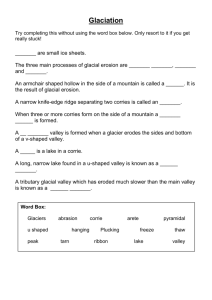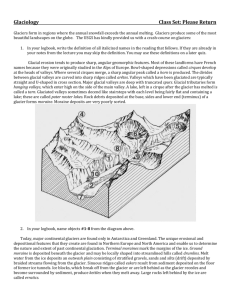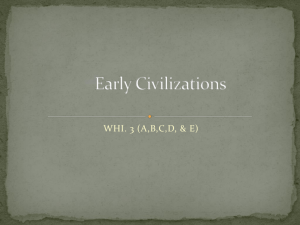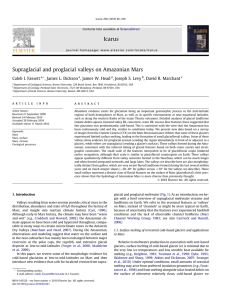SUPRAGLACIAL AND PROGLACIAL VALLEYS ON AMAZONIAN MARS. , J. L. Dickson ,
advertisement
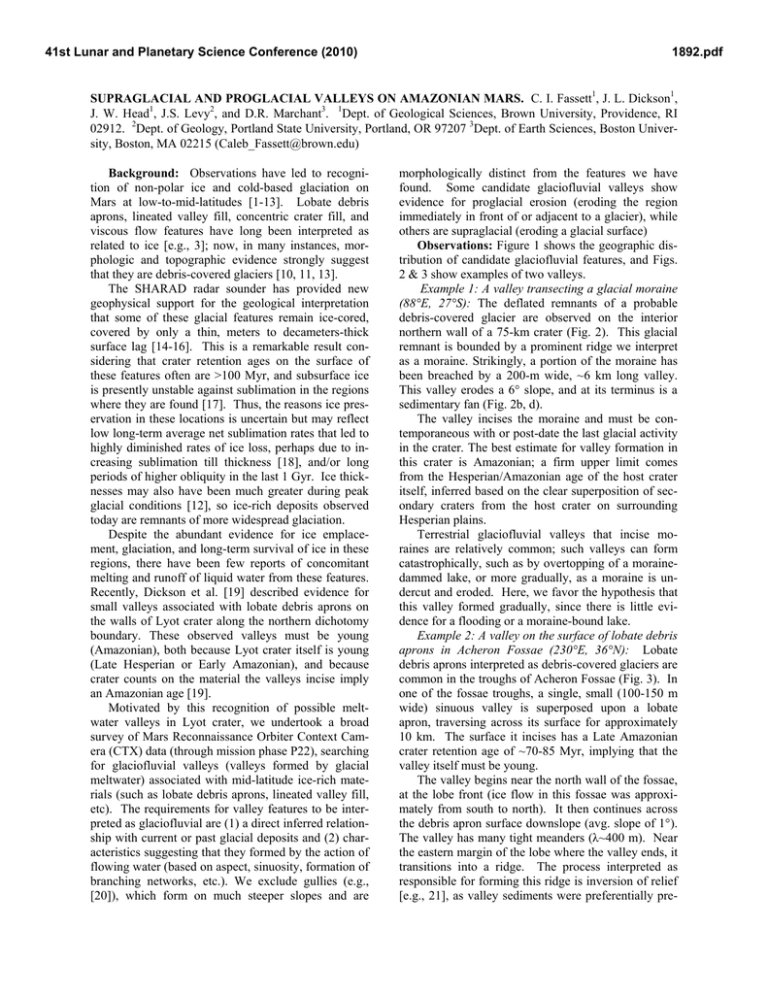
41st Lunar and Planetary Science Conference (2010) 1892.pdf SUPRAGLACIAL AND PROGLACIAL VALLEYS ON AMAZONIAN MARS. C. I. Fassett1, J. L. Dickson1, J. W. Head1, J.S. Levy2, and D.R. Marchant3. 1Dept. of Geological Sciences, Brown University, Providence, RI 02912. 2Dept. of Geology, Portland State University, Portland, OR 97207 3Dept. of Earth Sciences, Boston University, Boston, MA 02215 (Caleb_Fassett@brown.edu) Background: Observations have led to recognition of non-polar ice and cold-based glaciation on Mars at low-to-mid-latitudes [1-13]. Lobate debris aprons, lineated valley fill, concentric crater fill, and viscous flow features have long been interpreted as related to ice [e.g., 3]; now, in many instances, morphologic and topographic evidence strongly suggest that they are debris-covered glaciers [10, 11, 13]. The SHARAD radar sounder has provided new geophysical support for the geological interpretation that some of these glacial features remain ice-cored, covered by only a thin, meters to decameters-thick surface lag [14-16]. This is a remarkable result considering that crater retention ages on the surface of these features often are >100 Myr, and subsurface ice is presently unstable against sublimation in the regions where they are found [17]. Thus, the reasons ice preservation in these locations is uncertain but may reflect low long-term average net sublimation rates that led to highly diminished rates of ice loss, perhaps due to increasing sublimation till thickness [18], and/or long periods of higher obliquity in the last 1 Gyr. Ice thicknesses may also have been much greater during peak glacial conditions [12], so ice-rich deposits observed today are remnants of more widespread glaciation. Despite the abundant evidence for ice emplacement, glaciation, and long-term survival of ice in these regions, there have been few reports of concomitant melting and runoff of liquid water from these features. Recently, Dickson et al. [19] described evidence for small valleys associated with lobate debris aprons on the walls of Lyot crater along the northern dichotomy boundary. These observed valleys must be young (Amazonian), both because Lyot crater itself is young (Late Hesperian or Early Amazonian), and because crater counts on the material the valleys incise imply an Amazonian age [19]. Motivated by this recognition of possible meltwater valleys in Lyot crater, we undertook a broad survey of Mars Reconnaissance Orbiter Context Camera (CTX) data (through mission phase P22), searching for glaciofluvial valleys (valleys formed by glacial meltwater) associated with mid-latitude ice-rich materials (such as lobate debris aprons, lineated valley fill, etc). The requirements for valley features to be interpreted as glaciofluvial are (1) a direct inferred relationship with current or past glacial deposits and (2) characteristics suggesting that they formed by the action of flowing water (based on aspect, sinuosity, formation of branching networks, etc.). We exclude gullies (e.g., [20]), which form on much steeper slopes and are morphologically distinct from the features we have found. Some candidate glaciofluvial valleys show evidence for proglacial erosion (eroding the region immediately in front of or adjacent to a glacier), while others are supraglacial (eroding a glacial surface) Observations: Figure 1 shows the geographic distribution of candidate glaciofluvial features, and Figs. 2 & 3 show examples of two valleys. Example 1: A valley transecting a glacial moraine (88°E, 27°S): The deflated remnants of a probable debris-covered glacier are observed on the interior northern wall of a 75-km crater (Fig. 2). This glacial remnant is bounded by a prominent ridge we interpret as a moraine. Strikingly, a portion of the moraine has been breached by a 200-m wide, ~6 km long valley. This valley erodes a 6° slope, and at its terminus is a sedimentary fan (Fig. 2b, d). The valley incises the moraine and must be contemporaneous with or post-date the last glacial activity in the crater. The best estimate for valley formation in this crater is Amazonian; a firm upper limit comes from the Hesperian/Amazonian age of the host crater itself, inferred based on the clear superposition of secondary craters from the host crater on surrounding Hesperian plains. Terrestrial glaciofluvial valleys that incise moraines are relatively common; such valleys can form catastrophically, such as by overtopping of a morainedammed lake, or more gradually, as a moraine is undercut and eroded. Here, we favor the hypothesis that this valley formed gradually, since there is little evidence for a flooding or a moraine-bound lake. Example 2: A valley on the surface of lobate debris aprons in Acheron Fossae (230°E, 36°N): Lobate debris aprons interpreted as debris-covered glaciers are common in the troughs of Acheron Fossae (Fig. 3). In one of the fossae troughs, a single, small (100-150 m wide) sinuous valley is superposed upon a lobate apron, traversing across its surface for approximately 10 km. The surface it incises has a Late Amazonian crater retention age of ~70-85 Myr, implying that the valley itself must be young. The valley begins near the north wall of the fossae, at the lobe front (ice flow in this fossae was approximately from south to north). It then continues across the debris apron surface downslope (avg. slope of 1°). The valley has many tight meanders (λ~400 m). Near the eastern margin of the lobe where the valley ends, it transitions into a ridge. The process interpreted as responsible for forming this ridge is inversion of relief [e.g., 21], as valley sediments were preferentially pre- 41st Lunar and Planetary Science Conference (2010) served as ice downwasted. We interpret this feature as supraglacial, since it erodes the surface of the lobate debris apron. Implications and Conclusions: Since they clearly differ from gullies [20], which are initiated exclusively on much steeper slopes (20-30°), and valley networks [e.g., 22], which are much larger and up to several billion years older, we interpret these glaciofluvial valleys as a distinct class of fluvial features. The mechanism we favor for the origin of these valleys is top-down, insolation-induced melting, although the conditions that led to their formation remains unknown. The existence of these glaciofluvial valleys suggests that the hydrology of Amazonian Mars is more diverse than previously appreciated. References: [1] Squyres, S.W. (1979), JGR, 84(B14), 8087-8096. [2] Lucchita, B.K. (1981), Icarus, 45, 264-303. [3] Squyres, S.W., Carr, M.H. (1986), Science, 231, 249-252. [4] Head, J.W., Marchant, D.R. (2003), Geology, 31, 641- 1892.pdf 644. [5] Milliken, R.E. et al. (2003), JGR, 108, 5057. [6] Pierce, T.L., Crown, D.A., (2003), Icarus, 163, 46-65. [7] Kargel, J.S., (2004), Mars: A Warmer, Wetter Planet. London: Springer Press, 557 pp. [8] Hauber et al. (2005), Nature, 434, 356-361. [9] Head, J.W. et al., (2005). Nature, 434, 346-351. [10] Head, J.W. et al., (2006), EPSL, 241, 663-671. [11] Levy, J.S. et al. (2007), JGR, 112, E08004. [12] Dickson, J.L. et al. (2008), Geology, 36, 411-414. [13] Head, JW. et al. (2009), EPSL, doi: 10.1016/j.epsl.2009.06.041. [14] Holt, J.W. et al. (2008), Science, 322, 1235-1238. [15] Plaut, J.J. (2008), GRL, 36, L02203. [16] Safaeinili, A. et al. (2009), LPSC 40, abs. no. 1988. [17] Mellon, M.T., Jakosky, B.M. (1995), JGR, 100, 11,781-11,799. [18] Helbert et al., (2005), GRL, 32, L17201. [19] Dickson, J.L. et al. (2009), GRL, 36, L08021. [20] Malin, M.C., Edgett, K.S. (2000), Science, 288, 23302335. [21] Pain, C.F. et al. (2007), Icarus, 190, 471-478. [22] Carr, M.H. (1995) JGR, 100, 7479-7507.

